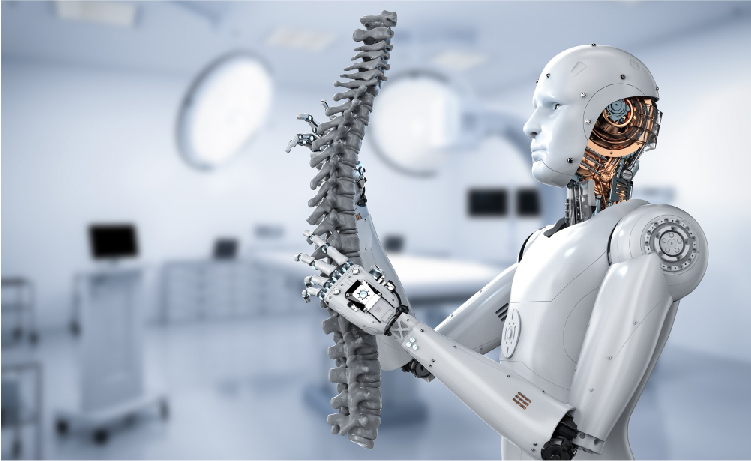Avg Price: $ 8500-$ 20000


Treatment Time
Recovery Time
Hospitalization Days
Success Rate
Robotic Spine Surgery, or Robot-assisted Spine Surgery, refers to the use of Robotic technology to provide guidance during Neurosurgical procedures on the Spine. Over the past decade, there has been a notable expansion in the involvement of robotic systems within the realm of surgical practices, giving rise to numerous innovations. More recently, the domain of Spine Surgery has witnessed the introduction of Robotic systems. It has become a practical resource for facilitating minimally invasive, more precise, and efficient placement of screws. Its capacity for real-time intraoperative navigation holds the promise of enhancing accuracy while reducing radiation exposure, complication rates, operative time, and recovery duration.
Several robotic systems have received approval from the U.S. Food and Drug Administration for use in these surgical procedures. Annually, more than 4.83 million spinal surgeries are conducted globally. To optimize and improve surgeon performance, robot-assisted systems have been created and implemented on a global scale. Presently, the application of robotic assistance is primarily limited to spinal fusion and instrumentation procedures. However, recent research has showcased its effectiveness in progressively intricate surgeries, including Spinal Tumor resections and ablations, Vertebroplasties, and Deformity correction.
India bears one-fifth of the global spinal disease burden, with a notable increase in spine injuries across all developing nations. In today's scenario, robotic spine surgery, plays a pivotal role in addressing the increasing spinal disease burden globally, with particular importance in a country like India. The procedure's availability in India not only addresses a significant portion of the world's spinal disease burden but also reflects advancements in medical technology and ensures that those in need have access to a safe and successful treatment option, thereby improving the overall quality of life for individuals dealing with spinal issues. As a result, finding the best doctors for Robotic Spine Surgery, and the best hospitals for Robotic Spine Surgery in India is getting easier and more affordable every year. If you're seeking insight, today, we'll shed light on this procedure and its details.
Robotic Spine Surgery is a surgery where a robot provides guidance and support to the surgeon, employing minimally invasive methods that contribute to heightened accuracy and precision. Particularly in instances involving degenerative discs, scoliosis, kyphosis, spinal column tumors, infection, fractures, and herniated discs, these approaches can result in smaller incisions, expedited recovery, reduced postoperative pain, and enhanced overall outcomes. Your healthcare providers will thoroughly assesses each patient and their specific condition to identify the most suitable form of treatment.
Why is Robotic Spine Surgery needed?
Surgeons choose Robotic Spine Surgery to address various conditions. Robotic systems have demonstrated successful application in the following spinal procedures:
Take Charge of Your Health
Book a Free Consultation

Categories of Robotic Spine Surgery include:
These types showcase the Versatility and effectiveness of Robotic systems in various Spinal procedures.
Pre-evaluation process for Robotic Spine Surgery involves following steps:
Your Health is Our Priority
Book a Free Consultation
Throughout the Robotic Spine Surgery, the goal is to optimize precision, minimize invasiveness, and enhance patient recovery. Its important to note that specific steps can vary based on the type of procedure and the particular robotic system being used. You can expect following during the procedure:
As is the case with any surgical procedure, Robotic Spine Surgery may also involve general and procedure-specific risks. Common general risks associated with this surgery are:
Procedure specific risks related to this surgery are:

Robotic Spine Surgery has the potential to reduce the recovery periods. Typically, individuals either return home on the same day or within one to two days, though the specific duration of hospital stay varies among individuals. In contrast, those undergoing traditional surgery usually remain in the hospital for three to five days.
Due to the minimally invasive nature of this technique, which minimizes disruption to muscles and soft tissues, postoperative pain tends to be less severe than that experienced after traditional open procedures. Although some discomfort is still expected, advancements in pain management facilitate more effective pain relief.
As part of your recovery strategy, your healthcare provider might recommend physical therapy depending upon the procedure and your overall physical condition. Tailored exercises will contribute to regaining strength, enabling a smoother transition back to work and daily activities.
Avail the Expert Health Advice
Book a Free Consultation
Robotic Spine Surgery is a spinal intervention that involves a recovery process and adjustments to accommodate the changes made to the spine. Here are key aspects to consider:
The advent of advanced navigation systems and robotic platforms marks a revolutionary phase in spine surgery. From the era of manual screw placement without image guidance, significant technological progress has transformed spine surgery, leading to greatly enhanced safety and quality of care.
In 2013, a study was conducted to compare three approaches for screw placement in an randomized controlled trial. These included Spine Robotic Surgery, fluoroscopy-guided placement, and freehand screw placement. The accuracy rates were 99.0%, 92.0%, and 97.5% for robot-assisted, fluoroscopy-guided, and freehand placement, respectively. This demonstrates the superior effectiveness of this surgical approach compared to others.
The cost of Robotic Spine Surgery in India is quite affordable than many Western nations, while still maintaining world-class quality. The approximate price of this procedure in India ranges from INR 7,05,000 ($8,500) to INR 16,60,000 ($20,000).
| Location | Minimum Cost ($) | Average Cost ($) | Maximum Cost ($) |
| Delhi | $ 10500 | $ 12000 | $ 15000 |
| Mumbai | $ 12000 | $ 15000 | $ 18000 |
| Chennai | $ 8500 | $ 15000 | $ 20000 |
| Hyderabad | $ 9500 | $ 15500 | $ 18000 |
The type and severity of the spinal disorders, the location of the hospital or clinic, and the surgeon's experience are a few of the variables that can affect the cost of robotic spine surgery. Other factors include:
Because of this, the cost of Robotic Spine Surgery might vary greatly depending on the patient's circumstances and the hospital or clinic they select. You can get an idea from a rough cost split.
|
Procedure |
Cost ($) |
|
Pre-surgery |
450-400 |
|
Cost of Robotic Spine Surgery & Hospital stay |
8500-20000 |
|
Post-surgery or Rehabilitation cost |
600-1000 |
The cost of diagnostics for Robotic Spine Surgery may include various preoperative evaluations and tests, such as blood test, urine test, and allergy test, that are typically conducted before the surgical procedure. These additional expenses can include diagnostic testing including CT scans, MRIs, PET scans, and biopsies. These tests can cost anything between INR 40,000 and INR 50,000.
MedFlick, your trusted healthcare companion, is dedicated to ensuring that your medical journey goes as smoothly and successfully as possible.
Fostering expertise backed by commitment, resilience and years of experience, we connect you to a wide network of India's best doctors
Explore the most advanced, reputable and trusted hospitals in India, offering the highest levels of clinical and surgical excellence

The worlds most trusted personalized health community with more than 1,00, 000 members that share their journey, experiences and health insights. Join your community and get access to make informed health decisions.
Explore



